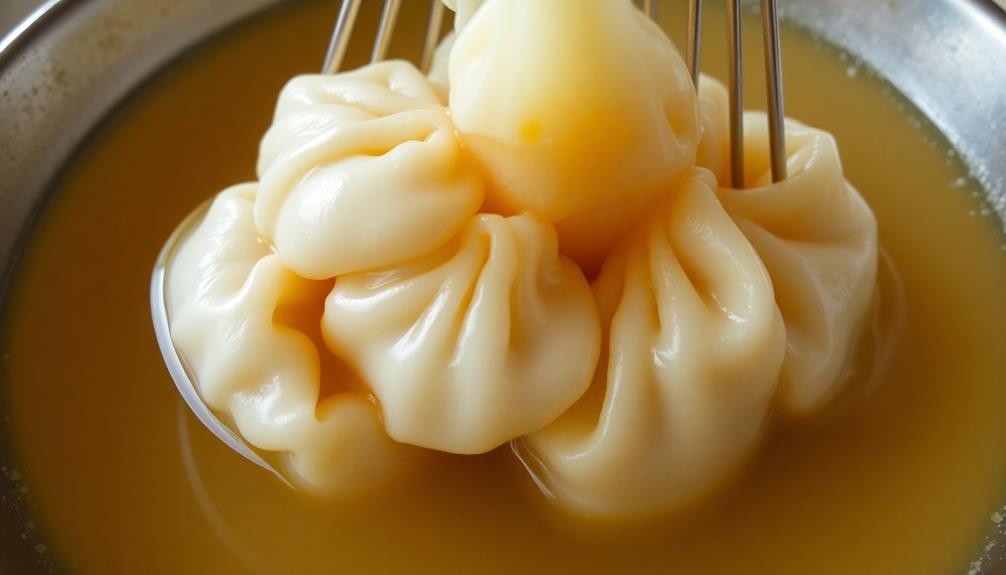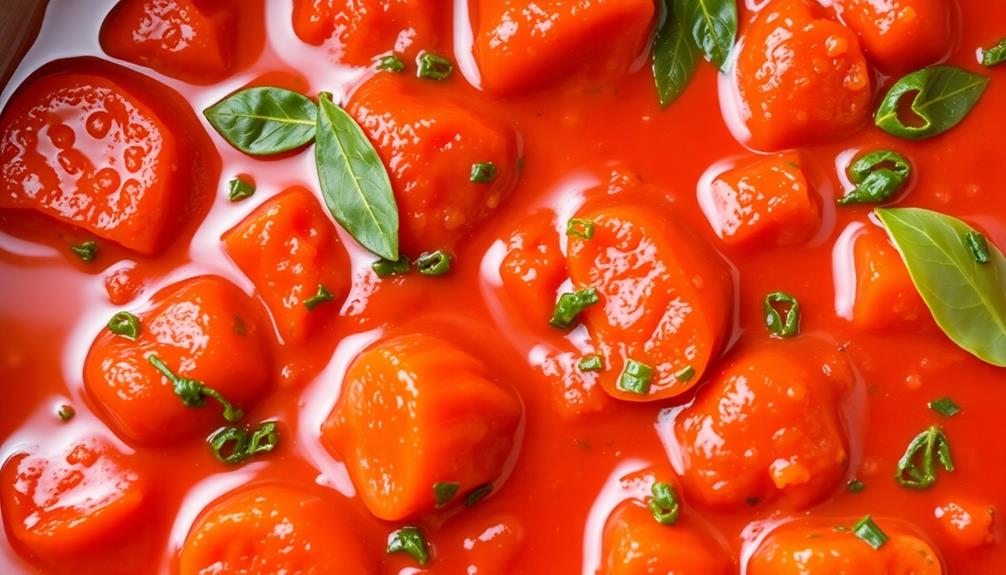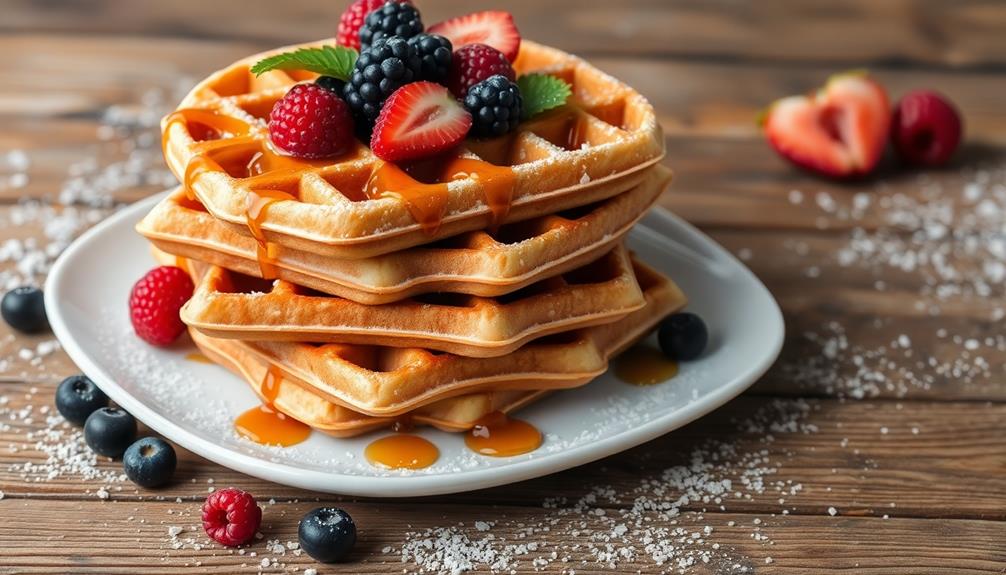Recreate the mouthwatering flavors of dumplings at home with this easy-to-follow recipe. Dumplings have origins dating back thousands of years in Asian cuisines, evolving into cherished regional specialties. This recipe uses simple ingredients like flour, water, and salt, with endless filling possibilities from savory to sweet. Carefully folding the dough enhances both presentation and taste. After simmering for 15-20 minutes, serve the tender dumplings hot with a variety of tasty toppings. Uncover more about this timeless dish, including cooking methods, serving suggestions, and the cultural significance of this beloved comfort food.
Key Takeaways
- Homemade dumplings require a simple dough made from flour, water, and salt, which can be filled with a variety of savory or sweet ingredients.
- The dough should be kneaded to develop gluten for a tender and pillowy texture, and then rested to relax the gluten before being shaped.
- Dumplings can be cooked using various methods, such as steaming, boiling, pan-frying, or baking, each of which affects the overall taste and texture.
- Serving dumplings hot with a variety of toppings, such as soy sauce, vinegar, chili oil, and scallions, allows for customization and enhances the dining experience.
- Dumplings hold cultural significance, symbolizing prosperity and unity, and the hand-making process can foster community and family traditions.
History

Dumplings have a long and storied history, dating back thousands of years to ancient civilizations across Asia. From the legendary Chinese jiaozi to the beloved Russian pelmeni, these delectable pockets of dough have been a staple in many cultures for centuries.
The earliest known dumplings were likely created by Chinese emperor Shennong, who's credited with introducing the concept of filling dough with meat and vegetables. Over time, the art of dumpling-making spread throughout the region, evolving into diverse regional specialties. In Japan, gyoza emerged as a beloved street food, while in Korea, mandu became a cherished part of the culinary tradition.
Dumplings haven't only nourished bodies but also hold deep cultural significance. They're often associated with important festivals and celebrations, symbolizing prosperity, unity, and good fortune.
The process of making dumplings by hand has also become a cherished family tradition, passed down through generations and fostering a sense of community and shared heritage.
Recipe

Homemade dumplings are a delightful and comforting dish that can be enjoyed year-round. These steamed pockets of dough are versatile and can be filled with a variety of savory or sweet fillings. Whether you're craving a classic pork and cabbage filling or a more adventurous mushroom and spinach variation, homemade dumplings are sure to satisfy.
The key to making delicious dumplings is in the preparation. Taking the time to carefully assemble and fold the dumplings will result in a beautifully presented dish that's sure to impress your family and friends.
- Flour (all-purpose or dumpling flour)
- Water
- Salt
- Pork (or other filling of your choice)
- Cabbage (or other vegetable filling)
- Soy sauce
- Sesame oil
- Ginger (fresh or ground)
- Garlic (minced)
To make the dumplings, begin by preparing the filling. In a mixing bowl, combine the pork, cabbage, soy sauce, sesame oil, ginger, and garlic. Mix well until the ingredients are thoroughly combined. Once the filling is ready, set it aside while you prepare the dumpling wrappers. Spoon a small amount of the filling onto each wrapper, then fold and seal the edges tightly. For a quick appetizer pairing, consider trying an easy homemade hummus recipe to serve alongside the dumplings for added variety and flavors at your next gathering. Once all the dumplings are assembled, you can either steam, boil, or pan-fry them depending on your preference. Serve the hot dumplings with a soy sauce or chili oil dipping sauce for extra flavor. For a fun twist, consider offering an easy homemade hummus on the side as a complementary dip, adding a unique fusion of Mediterranean flavors to accompany the traditional Asian dish.
Next, make the dough by combining the flour, water, and a pinch of salt. Knead the dough until it becomes smooth and elastic. Divide the dough into small balls and use a rolling pin to flatten them into thin wrappers.
Place a spoonful of the filling in the center of each wrapper, then fold the dough over and crimp the edges to seal the dumpling. Arrange the dumplings in a steamer basket and steam them for 15-20 minutes, or until they're cooked through.
For best results, serve the dumplings hot, with your favorite dipping sauces on the side. Enjoy the delicious combination of savory filling and tender dough in every bite.
Cooking Steps

To get started, you'll want to thoroughly mix the dough ingredients until they're well-combined.
Next, roll the dough into small, bite-sized balls.
Then, simply boil the dumplings in simmering broth until they're cooked through, drain them, and serve them hot with your favorite toppings.
Step 1. Mix Dough Ingredients Thoroughly

First, you'll want to gather all the ingredients for the dough and mix them thoroughly. In a large bowl, combine the flour, salt, and baking powder. Use a whisk to ensure the dry ingredients are evenly distributed.
Next, create a well in the center of the dry mixture and pour in the milk and melted butter. Using a fork or your fingers, gradually incorporate the wet ingredients into the dry ingredients, mixing until a shaggy dough forms. Knead the dough gently on a floured surface until it just comes together, being careful not to overwork it. If the dough feels too sticky, sprinkle in a little more flour, a tablespoon at a time. While this method is quick and simple compared to learning how to make sourdough starter, it still produces a deliciously rustic result that’s perfect for any occasion.
Once the dough comes together, turn it out onto a lightly floured surface and knead for about 2-3 minutes, until the dough is smooth and elastic. Be careful not to overwork the dough, as this can make the dumplings tough.
After kneading, cover the dough with a clean kitchen towel or plastic wrap and let it rest for 30 minutes. This resting period allows the gluten to relax, making the dough easier to roll out and shape.
Step 2. Roll Dough Into Small Balls

After the dough has rested, take small handfuls and roll them into 1-inch balls. This step ensures your dumplings have a consistent, uniform shape, which helps them cook evenly.
Lightly flour your hands and work surface before rolling to prevent the dough from sticking. Gently roll each piece of dough between your palms, applying just enough pressure to form a smooth, round ball.
Avoid overworking the dough, as this can make the dumplings tough. If the dough seems sticky, dust it lightly with more flour as needed.
Once rolled, place the dumplings on a lightly floured baking sheet or plate, spacing them about 1 inch apart. This prevents them from sticking together.
Cover the dumplings with a clean, damp towel to keep them from drying out while you work through the remaining dough.
Aim to make the dumplings roughly the same size so they cook at the same rate. This step lays the foundation for light, fluffy homemade dumplings.
Step 3. Boil Dumplings in Simmering Broth

Bring a large pot of broth or salted water to a gentle simmer over medium heat.
Once it's lightly bubbling, carefully add the prepared dumplings one by one, making sure they don't stick together. Gently stir the pot to prevent the dumplings from clumping.
Let the dumplings simmer for 15-20 minutes, or until they're cooked through. They'll float to the surface when they're done.
To test, use a slotted spoon to gently lift a dumpling out of the pot – it should be tender and hot all the way through.
As the dumplings cook, the broth will thicken slightly. Feel free to adjust the seasoning, adding more salt, pepper, or any other desired herbs and spices.
Serve the hot, fluffy dumplings in bowls with the flavorful broth spooned over the top. Garnish with chopped scallions, cilantro, or other fresh herbs, if desired.
Enjoy your homemade dumplings!
Step 4. Drain Cooked Dumplings From Broth

Once the dumplings have finished simmering and are cooked through, use a slotted spoon to carefully transfer them from the broth to a serving dish. This will allow any excess broth to drain off, preventing the dumplings from becoming soggy.
Gently transfer the cooked dumplings, making sure not to break them apart.
Next, take a moment to examine the broth. If it appears cloudy or has a lot of dumpling residue, you may want to strain it through a fine-mesh sieve before serving.
This will ensure a clear, refined broth that complements the dumplings perfectly.
Step 5. Serve Hot With Desired Toppings

Immediately serve the freshly cooked dumplings hot, accompanied by your desired toppings or sauces. The dumplings' delicate flavors and tender textures are best enjoyed when they're piping hot off the stove.
Consider offering a variety of tasty options to suit different preferences:
- Soy sauce: A classic pairing that brings a savory, umami-rich note.
- Vinegar: For a tangy contrast, try rice vinegar or black vinegar.
- Chili oil: Add a touch of heat and aromatic spices.
- Scallions or chives: Fresh herbs lend a bright, oniony flavor.
- Sesame seeds: Sprinkle on a nutty crunch.
- Toasted garlic or shallots: Crispy fried alliums add delightful textures.
Encourage your guests to customize their dumplings with their favorite toppings. The combinations are endless, allowing everyone to tailor the dish to their individual tastes.
Serve the dumplings immediately for the ultimate dining experience.
Final Thoughts

After all the hard work of preparing the dough, filling, and cooking the dumplings, you can now sit back and enjoy the fruits of your labor.
The smell of the freshly made dumplings wafting through your kitchen is sure to tantalize your senses and leave you eager to dive in.
As you take that first bite, you'll be rewarded with the perfect balance of textures and flavors.
The tender, pillowy dough encases the savory filling, creating a harmonious blend that melts in your mouth.
Whether you choose to top your dumplings with a drizzle of soy sauce, a sprinkle of green onions, or a dollop of chili oil, each addition will elevate the dish and make it uniquely your own.
Frequently Asked Questions
Can I Freeze the Dumplings for Later Use?
Yes, you can freeze the dumplings for later use. Freezing dumplings is a great way to have them on hand whenever you need them. Once frozen, they'll keep for several months and can be reheated and enjoyed just like fresh dumplings.
How Long Do Homemade Dumplings Keep in the Fridge?
Homemade dumplings can be stored in the refrigerator for up to 3-4 days. Make sure to keep them in an airtight container or resealable bag to prevent them from drying out. Enjoy your homemade treats within this time frame for best quality and taste.
Can I Use a Different Type of Flour for the Dough?
You can certainly use a different type of flour for the dumplings' dough. Experiment with alternatives like whole wheat, all-purpose, or even gluten-free flour to see which texture and flavor you prefer. The key is finding a dough that's easy to work with.
What Is the Best Way to Reheat Leftover Dumplings?
To reheat your leftover dumplings, you've got a few options. You can steam them, boil them, or even pan-fry them. Just be sure to add a touch of water or oil to prevent them from drying out.
Can I Substitute the Filling Ingredients With Other Options?
Yes, you can substitute the filling ingredients with other options. The great thing about dumplings is their versatility – you can get creative and experiment with different fillings to suit your tastes and dietary preferences.










